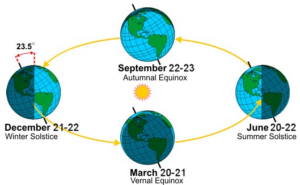
Astronomical winter begins at the winter solstice, which happened this year for the Northern Hemisphere at 9:27 p.m. Central Standard Time on Thursday, Dec. 21. Winter south of the equator begins in June.
The Northern Hemisphere winter solstice occurs at the time the sun is at its southernmost point in the sky. At this time, the sun is overhead at noon on the Tropic of Capricorn, approximately 23.4 degrees south of the equator.
The December solstice marks the longest night and shortest daylight of the year for those living in the Northern Hemisphere. For the Southern Hemisphere, it marks the shortest night and longest daylight. Although daylight hours increase during the winter months, temperatures continue to fall because Earth cools down and heats up slowly. The overall energy balance is still negative, with more heat lost at night than is regained during the daytime.
Meteorologists mark the start of our Northern Hemisphere winter as Dec. 1, with winter covering the three months of December, January, and February. These are the coldest months of the year. This means the time when daylight gets longer occurs during the Northern Hemisphere meteorological winter. Slowly at first, but at increasing daily intervals, as spring approaches.
For the Southern Hemisphere, meteorological winter covers the months of June, July, and August. For the Southern Hemisphere, the winter solstice occurs around June 21.
A day is not just the period of daylight. A day defined relative to the sun is called a solar day; it is the time from one local noon to the next. A sundial, correctly orientated, will indicate the precise moment of local solar noon, when the sun reaches its highest point in the sky each day. The longest solar days, as measured from one solar noon to the next, occur each year around the December solstice, no matter where you live.
Steve Ackerman and Jonathan Martin, professors in the UW-Madison department of atmospheric and oceanic sciences, are guests on WHA radio (970 AM) at 11:45 a.m. the last Monday of each month. Send them your questions at stevea@ssec.wisc.edu or jemarti1@wisc.edu.

